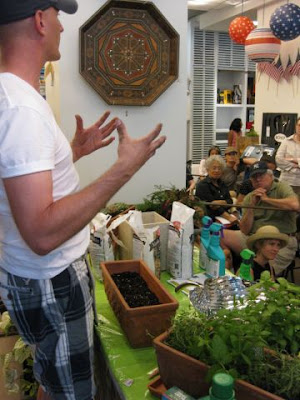
America's obsession in eradicating weeds from the landscape has become a full time job. Instead of spending so much money on chemicals and the time to apply them, we should start to re-direct our energies into harvesting these weeds for our consumption. Many weeds are not only edible, but they are turning up in our green markets being sold for a profit.
When you are frustrated with those patches of dandelions in your lawn or the ever present
clump of shotweed, instead of getting mad, get even...eat them! For centuries, plants we now refer to as 'weeds' were used for their nutritional value as well as medicinal properties. Many weeds attract beneficial insects and birds, while reducing insect predation on our desired plants.
The following list includes some of the tastiest intruders you'll encounter...
Taraxacum officinale, dandelion
This is probably the most identifiable weed on our list. All parts of the dandelion are edible, but the greens are high in vitamins A and C, and iron. Young leaves are delicious in a salad, while older leaves can be steamed or sauteed. My grandfather was fond of the wine made from the dandelion flowers.
Portulaca oleracea, purslane

In the heat of summer, purslane grows amazingly fast. It has one of the highest concentrations of Omega 3 fatty acids, five times the amount of spinach. The stems are high in vitamin C. It is wonderful cold in salads and cooked, has the nutritional benefits of okra.
Chenopodium album, lamb's quarter

The European relative of spinach, lamb's quarter bears large quantities of edible leaves from mid-spring to early fall. It is one of the best sources of beta-carotene, calcium, potassium, and iron. This annual can be cooked or used raw in salads.
Cardamine oligosperma, springcress or shotweed

Springcress, sometimes called bittercress, is a veracious grower. With spring-loaded seed pods, it throws seeds in a 10 foot radius. This plant is not only edible, but very nutritious. Young leaves can be added to salads, they have that familiar cress bite, or the plant can be cooked.
Tips on safe weed harvesting....- Always get permission before picking any plants on property that isn't yours
- Never eat a plant unless you have a positive identification for it and know for sure which parts are edible. Some plants are poisonous; some plants have certain parts that are poisonous. Do your rersearch.
- Never harvest plants that have been exposed to herbicides or pesticides, road salt, asphalt runoff or pet waste.
- Resist the urge to immediately replace all the greens in your diet with weeds! Instead, gradually introduce weeds to your meals.
- If you are on medication or pregnant, take the time to carefully research each plant so that you can ensure it is safe and compatable with any medications you may be taking. *
*Edible Weeds, Bobbi Gustafson & Corrina Marote

 Here we are at the Flower District, 28th street, discussing what to look for when you're shopping and purchasing plants at the market.
Here we are at the Flower District, 28th street, discussing what to look for when you're shopping and purchasing plants at the market. Some of the attentive audience at Gracious Home seemingly entranced by the lecture.
Some of the attentive audience at Gracious Home seemingly entranced by the lecture.
 In the process of creating a wonderful container garden for a shady area.
In the process of creating a wonderful container garden for a shady area.





 In the heat of summer, purslane grows amazingly fast. It has one of the highest concentrations of Omega 3 fatty acids, five times the amount of spinach. The stems are high in vitamin C. It is wonderful cold in salads and cooked, has the nutritional benefits of okra.
In the heat of summer, purslane grows amazingly fast. It has one of the highest concentrations of Omega 3 fatty acids, five times the amount of spinach. The stems are high in vitamin C. It is wonderful cold in salads and cooked, has the nutritional benefits of okra. The European relative of spinach, lamb's quarter bears large quantities of edible leaves from mid-spring to early fall. It is one of the best sources of beta-carotene, calcium, potassium, and iron. This annual can be cooked or used raw in salads.
The European relative of spinach, lamb's quarter bears large quantities of edible leaves from mid-spring to early fall. It is one of the best sources of beta-carotene, calcium, potassium, and iron. This annual can be cooked or used raw in salads. Springcress, sometimes called bittercress, is a veracious grower. With spring-loaded seed pods, it throws seeds in a 10 foot radius. This plant is not only edible, but very nutritious. Young leaves can be added to salads, they have that familiar cress bite, or the plant can be cooked.
Springcress, sometimes called bittercress, is a veracious grower. With spring-loaded seed pods, it throws seeds in a 10 foot radius. This plant is not only edible, but very nutritious. Young leaves can be added to salads, they have that familiar cress bite, or the plant can be cooked.